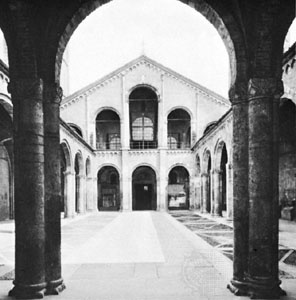atrium
architecture
in architecture, originally an open central court of a Roman house and later of a Christian basilica. In domestic and commercial architecture the concept of the atrium experienced a revival in the 20th century.
In Roman times the hearth was situated in the atrium. With the developing complexity of the domus (a more capacious residence), however, the kitchen and hearth were removed to other positions, and the atrium began to function as a formal reception room and as the official centre of family life. By the end of the Roman Republic, one or more colonnaded courts were added in the larger houses, removing from the atrium the last vestiges of family life. During the Roman Empire, the room virtually became the office of the owner of the house. Traditionally, the atrium held the altar to the family gods, the Lares. The atrium was designed either with or without columns; it had, universally, a marble basin known as the impluvium, which was situated in the centre of the room under the opening in the roof called the compluvium.
 The term atrium is used in a generic sense (like the English hall) for both consecrated and unconsecrated buildings such as the Atrium Vestae, where the Vestal Virgins lived, and the Atrium Libertatis, the residence of the Roman censor. In Rome the word atrium also signified any open court surrounded by porticoes placed in front of a temple. The concept of an atrium was also adopted by the early Christians. An open court, or atrium, surrounded by colonnades or arcades was often built in front of a Christian basilica. The churches of S. Clemente at Rome, S. Ambrogio at Milan, and the Basilica Eufrasiana of Parenzo (Poreč) in Istria (Croatia) still retain their atria.
The term atrium is used in a generic sense (like the English hall) for both consecrated and unconsecrated buildings such as the Atrium Vestae, where the Vestal Virgins lived, and the Atrium Libertatis, the residence of the Roman censor. In Rome the word atrium also signified any open court surrounded by porticoes placed in front of a temple. The concept of an atrium was also adopted by the early Christians. An open court, or atrium, surrounded by colonnades or arcades was often built in front of a Christian basilica. The churches of S. Clemente at Rome, S. Ambrogio at Milan, and the Basilica Eufrasiana of Parenzo (Poreč) in Istria (Croatia) still retain their atria.heart
in vertebrates and the higher invertebrates, heart chamber that receives blood into the heart and drives it into a ventricle, or chamber, for pumping blood away from the heart. Fishes have one atrium; amphibians, reptiles, birds, and mammals, two.
In humans the atria are the two upper chambers of the heart. Each is roughly cube-shaped except for an ear-shaped projection called an auricle. (The term auricle has also been applied, incorrectly, to the entire atrium.) The right atrium receives from the veins blood low in oxygen and high in carbon dioxide; this blood is transferred to the right lower chamber, or ventricle, and is pumped to the lungs. The left atrium receives from the lungs blood high in oxygen and low in carbon dioxide; this blood flows into the left ventricle and is pumped through the arteries to the tissues. The major openings in the walls of the right atrium are (1) the points of entrance for the superior and inferior venae cavae (the great veins that return blood from the bodily tissues), and for the coronary sinus, the dilated terminal part of the cardiac vein, bearing venous blood from the heart muscle itself; and (2) the opening into the right ventricle. The principal openings into the left atrium are the points of entry of the pulmonary veins, bringing oxygenated blood from the lungs, and the opening into the left ventricle. See also ventricle.
- Cheever, John
- Chefchaouene
- Che Guevara
- Chegutu
- Chehab, Fuad
- Cheilostomata
- Cheirolepis
- Cheju
- Cheju Island
- Cheka
- Cheke, Sir John
- Chekhov, Anton
- Chekiang
- Chelan, Lake
- chelate
- Cheliff, Ech-
- Chelif River
- Chellean industry
- Chelles
- Chelmno
- Chelmsford
- Chelmsford, Frederic John Napier Thesiger, 1st Viscount, Baron Chelmsford Of Chelmsford
- Chelomey, Vladimir Nikolayevich
- Chelsea
- Chelsea FC